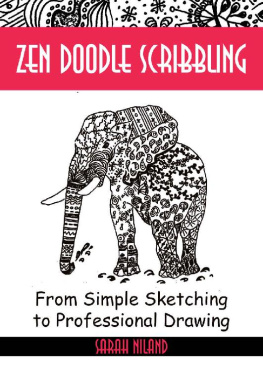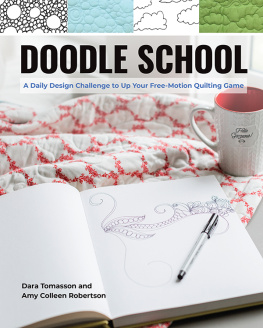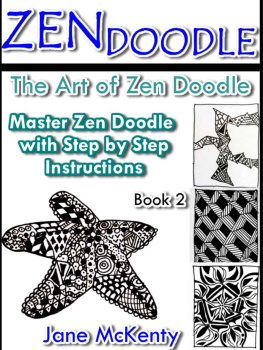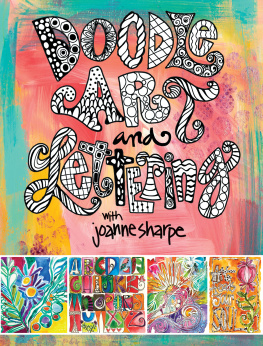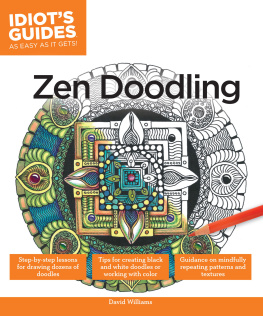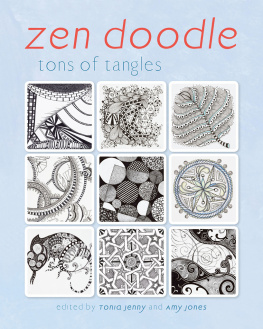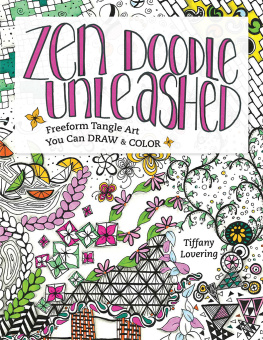Zen Doodle Scribbling Inventing Doodles like Never Before By Sarah Niland Copyright2016 Sarah Niland All Rights Reserved Copyright 2016 by Sarah Niland All rights reserved. No part of this publication may be reproduced, distributed, or transmitted in any form or by any means, including photocopying, recording, or other electronic or mechanical methods, without the prior written permission of the author, except in the case of brief quotations embodied in critical reviews and certain other noncommercial uses permitted by copyright law. Table of Contents Introduction Chapter 1 What your Doodles signify Chapter 2 Patterns of Zen Doodle
Conclusion Disclaimer While all attempts have been made to verify the information provided in this book, the author does assume any responsibility for errors, omissions, or contrary interpretations of the subject matter contained within. The information provided in this book is for educational and entertainment purposes only. The reader is responsible for his or her own actions and the author does not accept any responsibilities for any liabilities or damages, real or perceived, resulting from the use of this information. The trademarks that are used are without any consent, and the publication of the trademark is without permission or backing by the trademark owner.
All trademarks and brands within this book are for clarifying purposes only and are the owned by the owners themselves, not affiliated with this document.
Introduction
We often doodle, without even realizing that we are creating some forms on the backside of our notebook. More often than not, people often get embarrassed if they are caught doodling. To the surprise of many, these unintentional scribbles that you leave behind on paper margins, notepads, walls, or desktops have significant meaning. Many psychologists around the world have dedicated their lives to the research of doodling. Doodles can even be used to diagnose the emotional issues of people.
The symbols and shapes that you draw reveal a lot about your state of psyche. Even the most innocent and unintentional doodles can carry important messages from your subconscious mind. For instance, people often draw tree when they doodle, and a tree represents life and growth. If you draw a full-grown tree with loads of leaves, it suggests that you are vital and energetic, and you have a strong desire to live. On the other hand, if you draw a leafless tree with weak branches, which is often drawn by the elderly people, it represents a waning will to survive. Regarding interpretation of symbols, Carl Jung and Sigmund Freud, the pioneers of interpreting symbols, have studied a lot about the subconscious mind.
When you doodle, it becomes a type of free visual association and a method of tapping the reservoirs of deep self- knowledge that is contained in pictures rather than images. However, there are claims that the doodles of an artist mean completely different to him/ her than they do to the psychologist. To this claim, the researchers say that the inferences from the doodles can be drawn only after a careful study of an artists doodles over several years. Many symbols represent different meanings. You will read about such symbols and their meanings in the first chapter of this book. If you have read the previous version of this book, you will recognize many things in the Chapter 3 of this book.
Nevertheless, this book is also a complete version in itself. You will not find the need to pick up the previous book and flip through its pages. Just go on reading chapter by chapter and you will get the gist of doodling on your own.
Chapter 1
What your Doodles signify
Doodles say a lot about the personality and state of mind of a person, even if he/she is not an artist. When you are stuck somewhere and you incidentally have a pen or pencil in the hand, you might begin doodling anywhere you can. Now, whatever you choose to draw reveals almost everything about your mood and personality.
Since people doodle only when they are bored, they are only partially conscious about what they are drawing. It implies that their inner preoccupations come out on the paper. Some of the common symbols of doodles are stars, boxes, arrows, and flowers. These are the common symbols of feelings and aspirations. If you want to find out the true meaning of a doodle, you must look at the way it is drawn. Emotional people often desire harmony and yearn for affection; they tend to make use of curved lines and rounded shapes.
People who are practical or down to earth tend to make use of squares and straight lines. If you are a determined person, you might use zigzags, triangles, and corners. If you are hesitant towards other people, you might use sketchy, light strokes. Similarly, a large size of a doodle represents the outgoing and confident personality of a person. A smaller doodle suggests that a person likes to observe more willingly than participate. Face
- The expression on the face represents the character or mood of the doodler.
- Comic expression of the face represents the doodlers wish to grab the attention of people. Childish doodles indicate neediness. Profile of the face suggests introvert nature of the artist.
Chessboard Black and white boxes of the chessboard suggest persistence and patience of the doodler. You might be weighing the options of a tricky situation if you doodle a chequerboard. People who undergo mood swings also draw chessboard. Flowers Rounded soft petals around a spherical center of a flower suggest a family centric and amiable person.
In case you draw a circular center, but the petals are sharp, you might have a soft heart hiding behind a thorny defensiveness. Lively looking flowers suggest the sociable nature of the artist. If the flower heads are drooping, it represents the burden or worry of the doodler. Butterflies, bees, and birds Fluttering butterflies, bees, and birds suggest your romantic and flighty nature. You do not want to be strapped with the problems or tasks of life. Hearts A heart is definitely a romantic doodle and it suggests that you love someone.
Intricate Patterns If you draw highly detailed busy doodles, you have an obsessive nature and you would never allow letting go your loved ones or ambitions. Extreme introverts often draw these patterns. Ladder or Stairs These are the symbols of willingness and ambition to have your way of climbing up the staircase of progress. It also suggests that you have a long term and crucial task in hand. They also suggest a spiritual expedition and the desire to have more relaxation and happiness in life. Arrows The artist who draws arrows has a certain aim in mind.
If he draws an angular or sharp arrow, his target is something important. If the arrow is drawn decorated and more fluid, it suggests a love affair. Planes and Boats If you doodle any kind of transportation, it means that you want to escape from something. House A house in doodles suggests the want for security. If the house is drawn neat, it indicates a secure life at home. If the house is drawn messy or without windows, it suggests that, the artist is unhappy at home.
If the house is drawn on a hilltop, it suggests loneliness of the artist. Spider's Web A spiders web indicates a sense of being fenced in or the wish to entice a person into a relationship. Initials or Names People who doodle their initials or names often crave for attention. This is particularly common in teenagers. If you doodle the name of another person, it indicates that you are thinking about him/ her or you have a love affair with him/ her. It may also indicate that the other person has preoccupied your mind because they are a reason of some problem for you.

